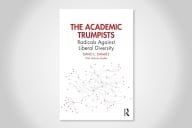You have /5 articles left.
Sign up for a free account or log in.
Why do some students move more smoothly from high school to college than do others? Much of the research focuses on issues of school resources and the differing quality of academic offerings, drawing attention to the advantages of students who attend wealthier high schools.
A new study published in the journal Sociology of Education points to a related, but less studied factor: the philosophy of high schools with regard to college advising. The study identifies three general styles of offices and notes the positive impact of the more ambitious approach – but also finds that this disappears when it comes to students whose choices are community college or not going to college at all.
The study – by Lori Diane Hill, assistant professor of education at the University of Michigan -- is based on a national database from high schools in major metropolitan areas, tracking where students ended up in college (or how many didn’t). The study divides counseling center philosophies into three categories, based on their activities: “traditional” (which doesn’t involve doing that much at all), “clearinghouse” (in which the office focuses on providing a wide range of materials on colleges, financial aid, etc.) and “brokering,” in which a much more active approach is taken.
On a series of measures, Hill found that brokering results in more of the types of activities that encourage college enrollment. Brokering counselors are more likely than others to encourage college visits, to assist with college applications, to help with financial aid applications, to contact college officials, and to contact parents.
While Hill found that brokering has become the dominant form of counseling, that is largely because of its use in private high schools. In the database, about one quarter of schools used a clearinghouse approach and 56 percent used the brokering approach, but almost half of the schools in the latter category were private. Relatively few private schools reported using the clearinghouse approach.
Hill focused on how the different methods might relate to key equity issues in college admission. One of the most encouraging findings was that the positive impacts of brokering apply across socioeconomic status. She analyzed the results of students’ college enrollment decisions based on their academic records, and found that there is strong evidence that brokering is applied equally across racial, ethnic and economic groups – in schools with the same philosophy. In other words, at a high school with brokering, two talented students – one wealthy and white and the other low income and minority – are both likely to gain from the brokering approach in ending up at a four-year college.
While Hill wasn’t surprised that brokering generally helped students, she said it wasn’t clear going in that this would be the case across the board. So she said this was encouraging.
The clearinghouse approach, she said, did not seem to hold back students if they were already poised to go to college. But the negative impacts of this approach appear to apply more for those that may or may not go to college.
On this issue, she found disappointing results at brokering schools too. The positive impact of brokering disappears when dealing with students whose academic performance suggests a choice between community college or no college.
While both clearinghouse and brokering approaches have some positive impact, the traditional (minimal) approach is used at schools with a disproportionate share of the black and Latino student population, Hill found. Not surprisingly, there is a wealth correlation with brokering schools.
In an interview, Hill said she hoped the study would prompt more attention to “school organizational infrastructure” – along with academic quality – in considering the factors that will help more students enroll in colleges. The finding is timely in light of many public schools reporting increasing counselor-to-student ratios, which can have the effect of creating de facto clearinghouse philosophies, even if the counselors would prefer more of a brokering approach.
At the same time, Hill said that her findings suggested the need for brokering counselors to learn more about community colleges and the options for students who may not be bound for four-year colleges. “What we need to recognized,” she said, “is that there is a population of students who require systematic institutionalized outreach.”








